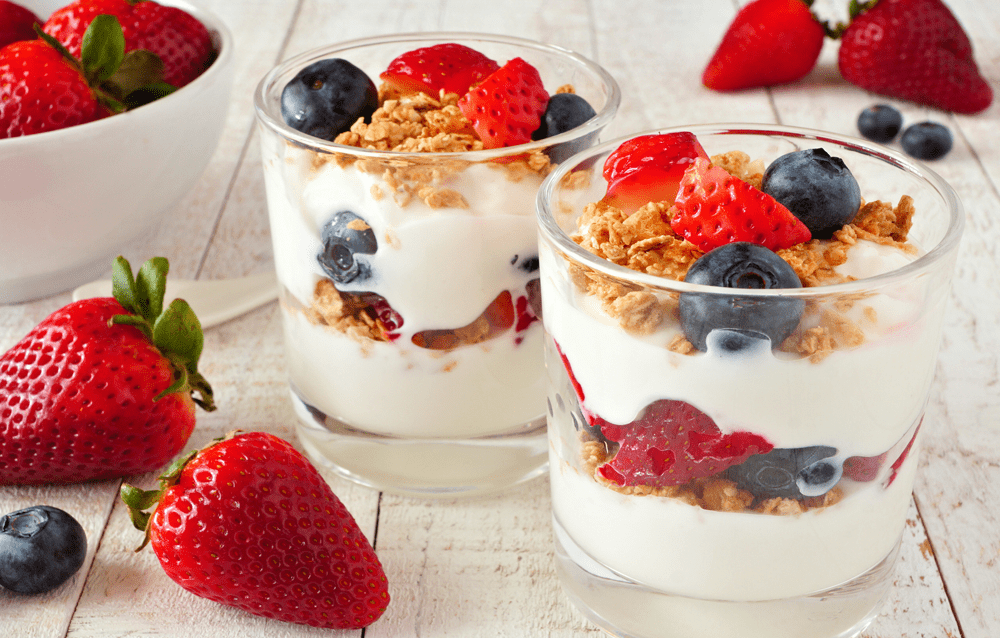How to keep pace with changing yogurt trends
Trends
March 4, 2019Reading time: 3 minutes
High-end dairy products are on the rise, driven by consumer demand for premium and specialty products. So how can brands ensure their dairy packaging delivers both performance and premiumization?
High-end dairy products are on the rise, driven by consumer demand for premium and specialty products. So how can brands ensure their dairy packaging delivers both performance and premiumization?

The dairy food sector is constantly in flux. Trends and tastes are shifting at incredible speed, leaving manufacturers with the tough job of staying relevant and keeping step with consumer behaviors.
These changes are being driven by health-conscious consumers looking for nutritional, on-the-go snacks and premium options. In response, dairy producers — particularly in the yoghurt category — are widening their ranges to include drinkable, high-protein, layered, probiotic and dessert-style options, as well as an impressive variety of flavors.
But as the depth and breadth of product ranges expands, the pressure on producers to deliver premium packaging and long shelf life is as acute as ever. Freshness, flavor and branding all need to be top quality to impress a consumer overwhelmed with choice.
Similar to the craft beer and connoisseur coffee movements, yoghurt is undergoing its own premiumization revolution. To succeed, dairy producers need to stay agile and overcome the following five challenges:
__1. The need to turn around smaller print runs __
Limited editions and specialty products are now commonplace given widespread premiumization makes it harder to stand out on the shelf. Manufacturers need to deliver small packaging production runs with incredibly short lead times to create a distinct product offering, helping them keep pace with the changing dairy products industry.
2. Getting to market faster than ever
Today, there are endless varieties and promotions all vying for attention. A fast rotation cycle on shelf reflects the dynamism of the dairy category, and means brands are under a lot of pressure to streamline their supply chains in order to keep up.
Die-Cut Lidding solutions have traditionally been difficult to manufacture in short time scales, making it tough to get new products to market at speed. But with some quantities now as low as 50,000 lids, the latest production techniques are giving dairy producers new options for testing and launching a diversified range of products. Die-Cut Lids can now be turned around in two or three weeks.
3. Maintaining food safety
The lid is the single most important component when it comes to food safety. It needs to be easy to use yet robust against puncture and leakage, while also meeting the requirements of food contact legislation and Hazard analysis and critical control points (HACCP). This type of protection is only possible using barrier technologies and process optimizations provided by packaging specialists such as Amcor.
4. Making your brand stand out
The look and feel of your premium products’ packaging is often the first point of contact with the consumer. This is why it’s essential that it offers the ideal blank canvas to deliver your carefully considered branding, information on provenance, and the product’s story and history (ensuring the careful craftsmanship of organic and artisanal yoghurt, for instance, is reflected in its packaging).
Amcor’s digital developments, such as MaXQ, introduce personalized ways for brands to interact with consumers and deliver additional information about the food they are eating. The quality of the materials – how they feel to the touch – is just as important as the design. Die-Cut Lids are an unmissable branding opportunity for dairy manufacturers to create a point of difference with high-quality print and color reproduction.
5. Taking sustainability seriously
To be taken seriously, you need to take sustainability seriously. Consumers demand environmental credentials on the products they buy. From the sourcing of the product itself to the recyclability of the packaging, expectations have shifted. Over 90% of our Die-Cut dairy range is recycling ready, which translates to a 63% reduction in C02 emissions and 79% reduction in water consumption. Amcor has pledged to make all of its packaging recyclable or reusable by 2025.
At Amcor, we’ve helped dairy manufacturers and distributors across the globe navigate these challenges and differentiate their packaging. Our longstanding customer base includes Dutch Mill in Asia and Arla Foods in Europe. Arla has recently added new machinery for shorter print runs, meaning improved sustainability and efficiency.
Responsiveness is the watchword in today’s dairy sector, and Die-Cut packaging takes you a long way on the path to achieving it. Our whitepaper, ‘Lifting the lid on dairy packaging: Five factors to consider when selecting Die-Cuts’ offers you a helping hand as you choose your next Die-Cut dairy packaging lid.
Related Insights
How ecommerce is changing snacking behaviors
May 27, 2019
Ecommerce is a cultural norm. Consumer concerns around quality, reliability and safety have long been assuaged by tech savvy direct-to-consumer startups and traditional retailers who look to stay relevant and competitive. Today, consumers expect fast, seamless delivery models to match their busy lifestyles and this doesn’t just apply to high priced electronics, clothing and furniture but lower...
Ecommerce is a cultural norm. Consumer concerns around quality, reliability and safety have long been assuaged by tech savvy direct-to-consumer startups and traditional retailers who look to stay relevant and competitive. Today, consumers expect fast, seamless delivery models to match their busy lifestyles and this doesn’t just apply to high priced electronics, clothing and furniture but lower...
4 Plastic Packaging Myths Busted
January 29, 2019
At this year’s Sustainable Retail Summit, I asked a simple but profound question: can plastic packaging and the circular economy ever co-exist? I also explored packaging myths and attempted to separate fact from fiction.
At this year’s Sustainable Retail Summit, I asked a simple but profound question: can plastic packaging and the circular economy ever co-exist? I also explored packaging myths and attempted to separate fact from fiction.

